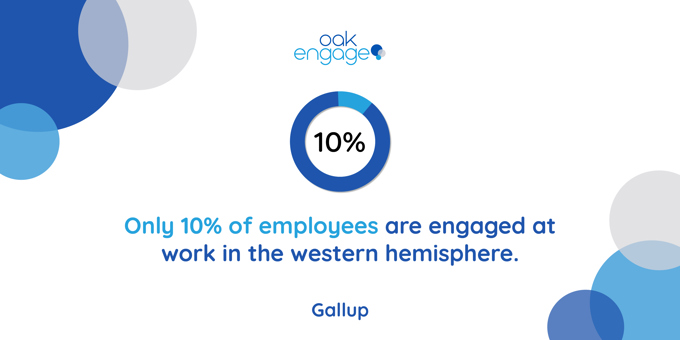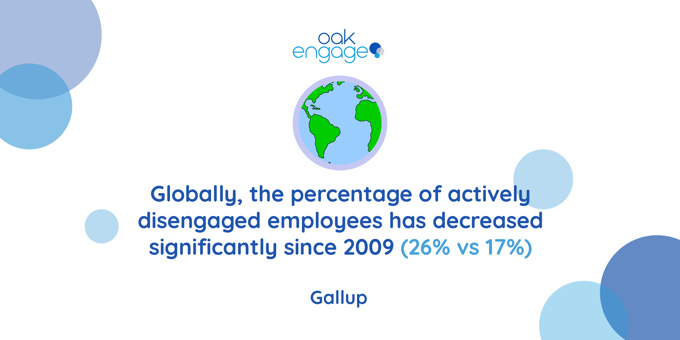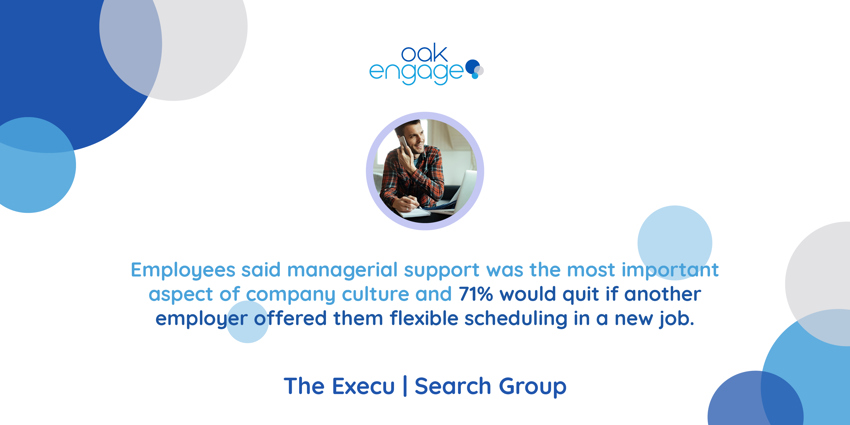What Is Employee Engagement?
Employee engagement is the emotional commitment that an employee has to their organisation and its goals.
This emotional commitment means engaged employees actually care about their work and their company. They don't work just for the pay, but work on behalf of the organisation's goals, ultimately creating more success for the company.
Recommended Reading 📖 Employee Engagement: The Ultimate Guide for 2021
25 Statistics on Employee Engagement

1. 85% Of Employees Are Not Engaged at Work
In its State Of The Global Workplace report, Gallup concludes that “85% of employees are not actively engaged or (are) actively disengaged at work.” This means that only 15% of employees are actively engaged.
This suggests that the majority of workforces around the world are either viewing their workplace negatively or are only doing the bare minimum to make it through the day, with little to no emotional attachment.

2. Employees Who Find a Passion and Purpose at Work Are More Than 3 Times as Likely to Stay With Their Organisations Than Those Who Don’t.
(Source: New York Times)
Engagement in the workplace isn't just about getting the work done, it's about having a passion for what you do and wanting your company to succeed. Employees with this mindset usually have a great company culture.

3. Only 10% Of Employees Are Engaged at Work in the Western Hemisphere.
According to The State Of The Global Workplace report, only 10% of employees are engaged at work in the Western hemisphere. Engagement rates differ around the world but nonetheless 10% is quite shocking to see...The importance of engaging your workforce is vital for your business success.

4. The Most Disengaged Employees Are Office, Sales, and Construction Workers - With Only a 12% Engagement Rate.
With office, sales and construction workers only having a 12% engagement rate, an employee engagement platform is vital to connect employees wherever they are.
In today's interconnected world, organisations are spreading their operations across multiple countries and time zones.
This brings up a myriad of communication and connectivity challenges when attempting to work seamlessly as a global structure. With the help of a modern intranet platform however, companies can be brought closer together through better business connectivity and by enabling workforces to work better as one.

5. Globally, the Percentage of Actively Disengaged Employees Has Decreased Significantly Since 2009 (26% Vs 17%).
With more and more companies using intranet software to engage their employees, the percentage of actively disengaged employees has decreased exponentially over the last decade, reducing by 12%.

6. Highly Engaged Employees Result in a 23% Increase in Profitability.
(Souce: Gallup)
With engaged employees comes an increase in business profits. When your workforce wants their company to succeed and complete their job to the better of their ability, your company will reap the rewards.

7. Businesses That Engage Their Employees Actively See an 18% Decrease in Staff Turnover.
According to the State Of The Global Workplace report, actively engaged employees to see an 18% decrease in staff turnover. While it’s impossible to bring your employee retention to zero, it’s certainly possible to create a loyal workforce where your people stay with your organisation for a prolonged time period.

8. Only 16% Of Employees Use Technology to Monitor Engagement.
A Gartner analysis shows that only 16% of employers are using technologies to monitor their employees' level of engagement. They may be using methods such as virtual clocking in and out, tracking work computer usage, and monitoring employee emails or internal communications/chat. While some companies track productivity, others monitor employee engagement and well-being to better understand the employee experience.

It’s becoming increasingly important for organizations to connect their employees through technology. The most efficient way to do this is through a company intranet platform. Employee monitoring tools are also available to make sure management follows the best practices to ensure high employee engagement.
9. 33% Of Employees Leave Their Jobs for New Challenges.
Nearly 5,000 professionals surveyed by Korn Ferry say that being bored and needing a challenge would be the top reason for seeking a new job.
Employee retention is one of the biggest problems that a company has to deal with. Organisations are battling with each other to secure the best skills and talent, and while it may cost a business to offer attractive benefits, it can cost a lot more to lose your employees to another competitor.

10. Only 29% Of Employees Are Satisfied With Available Career Advancement Opportunities.
SHRM research examined 44 aspects of job satisfaction and 38 factors directly related to employee engagement. With only 29% of employees being satisfied with available career advancement opportunities, there is clearly still work to be done.

11. 85% Of Employees Are Most Motivated When Internal Communications Are Effective.
According to Trade Press Services, 85% of employees say they’re most motivated when management offers regular updates on company news. Employee awareness of company goals and challenges accompanied by a clear definition of their role, leads to motivation. Furthermore, if employees are engaged in the company, profits will start to increase.

12. 38% Of Remote Employees Feel Exhausted After Daily Virtual Meetings.
A Doodle survey of more than 1,100 U.S. employees cited symptoms of burnout among employees. Suffice to say, burnout needs to be taken seriously, and preventing it from happening is key to the long term health of employees.
We need to better understand what causes people to feel motivated in our organizations, and what causes them frustration.

13. Disengaged Employees Have a 48% Higher Likelihood of Daily Stress.
(Source: Gallup )
The success of our employees is something that should be celebrated every day, but for many businesses employee appreciation is pushed to the bottom of the priority list.
Although many companies put employee appreciation on the back burner, there is evidence that shows giving your employees recognition every once in a while does pay off. Better employee engagement, improved productivity, retained business success and higher morale are all outcomes of showing appreciation.

14. Engaged Employees Reduce Absenteeism by 41%.
Organizations have more success with engagement and improve business performance when they treat employees as stakeholders of their own future and the company's future. This means focusing on concrete performance management activities, such as clarifying work expectations, getting people what they need to do their work, providing development and promoting positive coworker relationships.

According to Gallup, engaged employees make it a point to show up to work and do more work -- highly engaged business units realize a 41% reduction in absenteeism and a 17% increase in productivity.
15. Highly Engaged Businesses Achieve 59% Less Turnover.
Gallup suggests that highly engaged businesses achieve 59% less turnover. When your turnover is low, you save money by avoiding unnecessary mistakes. Lower turnover can also have a beneficial effect on the payroll even if you pay your long-term employees well because you don’t have to train new workers and you avoid losing efficiency while they get up to speed.

16. Thriving Employees Have 53% Fewer Missed Days Due to Health Issues.
Thriving employees have 53% fewer missed days due to health issues. Suffering and struggling employees have a substantially higher disease burden due to diagnoses of depression and anxiety, among others. This translates into big differences in productivity.

17. 90% Of Leaders Think an Engagement Strategy Has an Impact on Business Success but Barely 25% Of Them Have a Strategy.
(Source: The Muse)
The first step in keeping your employees engaged is keeping tabs on how they are feeling. Companies should be conducting weekly, anonymous surveys that will allow employees to express themselves and their concerns.

Features such as Pulse Surveys on your company intranet, are quick and efficient that help you collect data from your team, giving you both a view on how everyone is feeling, as well as specific feedback.
Read our 31 Intranet Features Your Company Needs to heighten your employee engagement rates.
18. 43% Of Highly Engaged Employees Receive Feedback at Least Once a Week, Compared to Only 18% Of Employees With Low Engagement.
(Source: The Muse)
Employee recognition and feedback in the workplace has to be a vital part of a company's culture. In today’s work environment, the companies with the most satisfied and engaged employees are the ones that have the best training programmes and skilled staff. However, even the best employees cannot perform well when they are not motivated enough. Make sure employee feedback stays constant.

19. Only 22% Of Companies Know What’s Driving Their Employee Disengagement.
The Predictive Index conducted a survey of 600 CEOs, presidents and VPs to find out how many companies had a talent strategy - and if so, whether that strategy drove business success. Unbelievably, only 22% of companies know what’s driving their employee disengagement, that’s why it's so important to have an employee engagement strategy in place, aligned with your company culture.

20. Actively Disengaged Employees Cost Their Organizations $483 to $605 Billion per Year.
Gallup suggests in its State Of The American Workplace report that actively disengaged employees cost their organizations $483 to $605 billion per year. This is an extraordinary amount of money, which can be easily cut if more workforces are engaged.

21. 77% Of Companies Focus on Employee Experience to Increase Retention.
A report by LinkedIn (Global Talent Trends 2020) suggests that 77% of companies focus on employee experience to increase retention. This is great to see. The better experience an employee has at work will create an emotional attachment, therefore leaving them less likely to leave the company.

22. Great Onboarding Experience Can Improve Employee Retention by 82% And Productivity by Over 70%.
(Source: Glassdoor)
Having a great onboarding strategy is crucial and sets the scene for your new hire. A perfect way to engage your new employees through your digital workplace is setting up a new starter hub. Ensure all documentation and information such as company policies and uniform information is stored here for ease of access.

23. 77% Of Employees Agree a Strong Culture Allows Them to Do Their Best Work.
Eagle Hill Consulting's new national Workplace Culture Survey suggests 76% of employees see the impact in productivity and efficiency, and another 74% draw a correlation between culture and their ability to serve their customer base.
Maintaining a great company culture is something that is essential to all businesses. Without it, your employees will feel disengaged and less motivated at work.

24. 68% Of Employees Would Consider Leaving Their Job if They Didn’t Feel Supported by More Senior Employees.
As found by Staples Workplace Survey 2019, the connection between management and employees is essential to create high employee engagement in the workplace. With a shocking 68% not being supported by management, companies need to be ensuring they support their employees in any way they can.

25. Employees Said Managerial Support Was the Most Important Aspect of Company Culture and 71% Would Quit if Another Employer Offered Them Flexible Scheduling in a New Job.
With 71% of employees considering a job change if they were offered a more flexible working schedule, employers are falling short in terms of work-life balance. Well-being in the workplace is vital for employees to feel recognised and engaged in their work. It is extremely important as employees spend a majority of their time at work, the average person will spend around 90,000 hours at work; that’s one-third of a lifetime.

Want to see more from Oak?
Get a demo with one of our digital workplace experts and see how Oak can help address your employee engagement issues today



